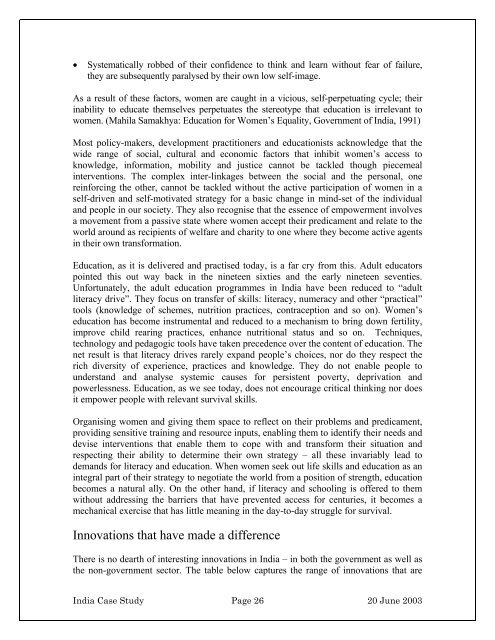Where are we today with respect to girls' education
Where are we today with respect to girls' education
Where are we today with respect to girls' education
- No tags were found...
Create successful ePaper yourself
Turn your PDF publications into a flip-book with our unique Google optimized e-Paper software.
• Systematically robbed of their confidence <strong>to</strong> think and learn <strong>with</strong>out fear of failure,they <strong>are</strong> subsequently paralysed by their own low self-image.As a result of these fac<strong>to</strong>rs, women <strong>are</strong> caught in a vicious, self-perpetuating cycle; theirinability <strong>to</strong> educate themselves perpetuates the stereotype that <strong>education</strong> is irrelevant <strong>to</strong>women. (Mahila Samakhya: Education for Women’s Equality, Government of India, 1991)Most policy-makers, development practitioners and <strong>education</strong>ists acknowledge that thewide range of social, cultural and economic fac<strong>to</strong>rs that inhibit women’s access <strong>to</strong>knowledge, information, mobility and justice cannot be tackled though piecemealinterventions. The complex inter-linkages bet<strong>we</strong>en the social and the personal, onereinforcing the other, cannot be tackled <strong>with</strong>out the active participation of women in aself-driven and self-motivated strategy for a basic change in mind-set of the individualand people in our society. They also recognise that the essence of empo<strong>we</strong>rment involvesa movement from a passive state where women accept their predicament and relate <strong>to</strong> theworld around as recipients of <strong>we</strong>lf<strong>are</strong> and charity <strong>to</strong> one where they become active agentsin their own transformation.Education, as it is delivered and practised <strong><strong>to</strong>day</strong>, is a far cry from this. Adult educa<strong>to</strong>rspointed this out way back in the nineteen sixties and the early nineteen seventies.Unfortunately, the adult <strong>education</strong> programmes in India have been reduced <strong>to</strong> “adultliteracy drive”. They focus on transfer of skills: literacy, numeracy and other “practical”<strong>to</strong>ols (knowledge of schemes, nutrition practices, contraception and so on). Women’s<strong>education</strong> has become instrumental and reduced <strong>to</strong> a mechanism <strong>to</strong> bring down fertility,improve child rearing practices, enhance nutritional status and so on. Techniques,technology and pedagogic <strong>to</strong>ols have taken precedence over the content of <strong>education</strong>. Thenet result is that literacy drives r<strong>are</strong>ly expand people’s choices, nor do they <strong>respect</strong> therich diversity of experience, practices and knowledge. They do not enable people <strong>to</strong>understand and analyse systemic causes for persistent poverty, deprivation andpo<strong>we</strong>rlessness. Education, as <strong>we</strong> see <strong><strong>to</strong>day</strong>, does not encourage critical thinking nor doesit empo<strong>we</strong>r people <strong>with</strong> relevant survival skills.Organising women and giving them space <strong>to</strong> reflect on their problems and predicament,providing sensitive training and resource inputs, enabling them <strong>to</strong> identify their needs anddevise interventions that enable them <strong>to</strong> cope <strong>with</strong> and transform their situation and<strong>respect</strong>ing their ability <strong>to</strong> determine their own strategy – all these invariably lead <strong>to</strong>demands for literacy and <strong>education</strong>. When women seek out life skills and <strong>education</strong> as anintegral part of their strategy <strong>to</strong> negotiate the world from a position of strength, <strong>education</strong>becomes a natural ally. On the other hand, if literacy and schooling is offered <strong>to</strong> them<strong>with</strong>out addressing the barriers that have prevented access for centuries, it becomes amechanical exercise that has little meaning in the day-<strong>to</strong>-day struggle for survival.Innovations that have made a differenceThere is no dearth of interesting innovations in India – in both the government as <strong>we</strong>ll asthe non-government sec<strong>to</strong>r. The table below captures the range of innovations that <strong>are</strong>India Case Study Page 26 20 June 2003












